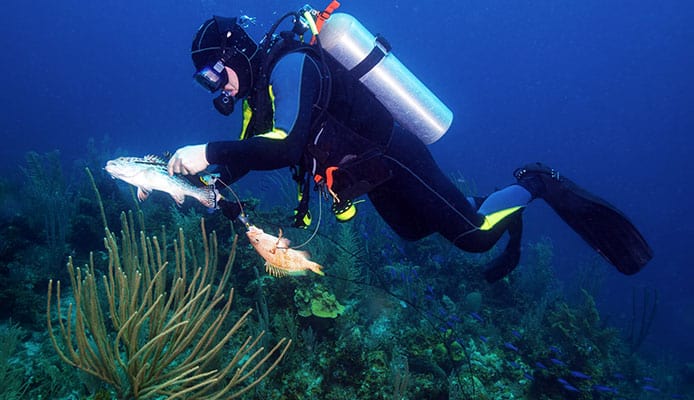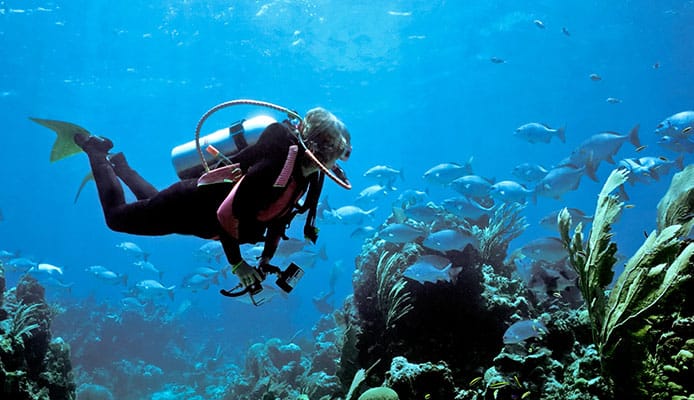
If you have a keen interest in scuba diving then you’ve probably heard of decompression sickness. You know that it can be dangerous and that the worst-case scenario can cause nerve damage and even death. It’s necessary to check out the 10 pro tips to avoid decompression sickness.
That is why it’s important to adhere to the no-decompression limit when diving.
Going beyond the no-decompression limit will require the diver to avoid rising directly to the surface of the water but instead make regular safety stops during his accent. As a diver, if you plan on staying under for longer than the no-decompression limit, then you will need specialized training and understand the various scuba diving dangers and risks.
A major factor in the no-decompression limit
The main factor affecting the NDL is Nitrogen. This gas is part of what is in a scuba diving tank. Due to the pressure of the water, the body will absorb the nitrogen from the gas in the scuba tank. As the diver ascends, there is less pressure which causes the nitrogen to expand.
This results in bubbles in the tissues and joints causing decompression sickness. To make sure the diver is safe, he needs to figure out a way of getting rid of the nitrogen in his tissues. This is done by making safety stops as he ascends. These safety steps are also known as decompression stops.
Factors affecting the amount of nitrogen absorbed in the body
When ndl diving, there are a few things that you will need to keep in mind at all times when it comes to how the body absorbs nitrogen.
The first one is time. The longer you stay under the more nitrogen your body is going to absorb.
The second is the depth. There is more pressure at greater depths than at lower depths which means that the body is going to absorb more nitrogen at greater depths than at lower depths.
The third factor to keep in mind is the type of gas in your scuba tank, obviously, the air has more nitrogen than other gas mixtures such as nitrox. Is scuba diving with nitrox dangerous? The more nitrogen you breathe, the more nitrogen is going to get absorbed in the body.
Lastly is the time between dives. A diver’s no-decompression limit will be shorter the second time he dives since nitrogen will still be in his body tissues especially if the duration between dives is less than six hours.
When should a dive calculate the no-decompression limit?
First of all, each diver should calculate his own no-decompression limit and he should do so before he takes the plunge. This will take into account the factors we’ve mentioned above.
You cannot use the decompression limit of your dive buddy as he may have made a previous dive. Find out all you need to know about the buddy system. These factors make each diver’s situation unique.
Once having calculated your own no-decompression limit, it is up to you to ensure that you observe it.
The contingency plan
When diving, a clever diver should not only have any decompression limit calculated but should also have a contingency plan if he accidentally goes beyond his planned depth or exceeds his no-decompression limit.
The most effective way to do this is to have your no-decompression limit calculated. One should be for the planned depth and the other should be for a slightly greater depth. You can find out your depth by taking regular checks on your dive computer.
For example, if the diver is planning to go down 60 feet, he needs to calculate the no-decompression limit of 60 feet as well as 70 feet. In case he exceeds his depth, all he needs to do is to switch to the no-decompression limit for 70 feet.
Don’t hit your any decompression limit
Simply put, mathematical algorithms are used when calculating the no-decompression limit. The result is intended to prevent you from getting decompression sickness.
In a real situation, however, other factors may affect the body’s ability to get rid of nitrogen such as if you have been diving for consecutive days or have been diving in cold water. Check out the beginner’s guide to ice diving.
This is why it’s always important not to hit your no-decompression limit.
In fact, when you are near your ndl diving, it’s a good idea to ascend slightly. This will give you enough time to figure out what to do when your no decompression limit is reached.
Otherwise, always ascend before getting to your ndl to give your body enough leeway to get rid of the absorbed as well as to prevent your body from absorbing any more nitrogen. This will ensure you remain in the safe zone and prevent any of the 18 things you should know about nitrogen narcosis.
You might also be interested in:
How To Calculate Maximum Operating Depth (MOD) In Scuba Diving?
10 Diving Concepts to Always Remember
Dive tables
For first time divers, reading the dive table can seem intimidating. Take the PADI dive table for example which has 27 rows and columns. All the numbers here can seem complicated at first. However, after going through the dive table and taking a few dives, you should quickly realize that it is not actually that difficult to read it.
The PADI dive table is an important tool during and diving. Those numbers are highly reliable as they’ve been arrived at through numerous dives and extensive research.
Globo Surf Overview
Ndl diving is important as it is the best way to ensure that you do not get decompression sickness. You want to spend your time underwater knowing that you will be safe to make a next dive. Always make sure you are aware of your no-decompression limit.


